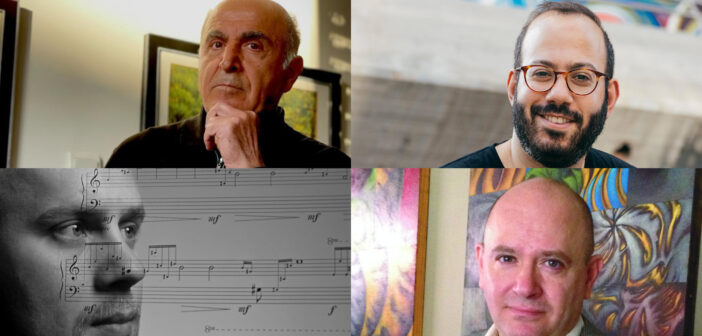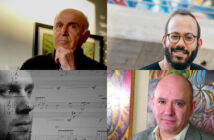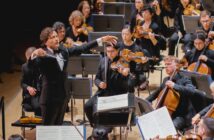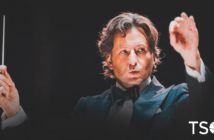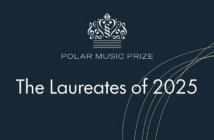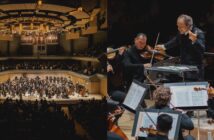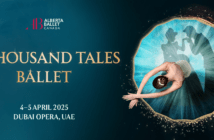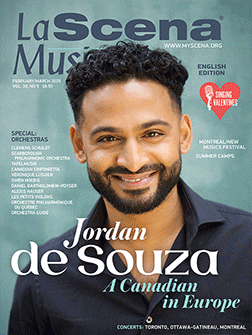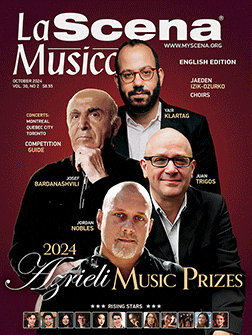
This page is also available in / Cette page est également disponible en:
![]() Francais (French)
Francais (French)
Composers Yair Klartag, Josef Bardanashvili, Jordan Nobles and Juan Trigos are the 2024 Azrieli Music Prizes laureates, named by the Azrieli Foundation. This biennial competition aims to discover, elevate and amplify artistic voices that exhibit excellence. This year, Klartag was awarded the Azrieli Commission for Jewish Music; Bardanashvili, the Azrieli Prize for Jewish Music; Nobles, the Azrieli Commission for Canadian Music and Trigos, the first-ever Azrieli Commission for International Music—a prize created to promote greater intercultural understanding.
Each composer will receive a prize package valued at over $200,000, including a cash award of $50,000; a world-première performance of their prize-winning work at Montreal’s Maison symphonique on Oct. 28 with members of Orchestre symphonique de Montréal and the OSM Chorus under conductor Andrew Megill. The prize also includes two subsequent international performances; and a professional recording.
This year’s selection panel included Chaya Czernowin, Tania León, Dr. Neil W. Levin, Samy Moussa, Gerard Schwarz and Ana Sokolović.
Yair Klartag: Exploring the juncture between rationalism and mysticism

“Coming from a very scientific background,” Klartag says, “music used to be a place of rebellion” against structure and empirical thinking. It was free, it had no rules. This was opposite to his upbringing, he says, which was coloured by logic and reason. It was not until recently, however, that he aimed to bring the rational and irrational together in his compositions.
He did this in a piece called “Rationale,” in which he explores the tradition of Jewish rationalism. Klartag looked to the writing of significant Jewish thinkers, who used reason and logic to explain the metaphysical. In “Rationale,” for soprano and instrumental ensemble, he used a text by Maimonides in which the medieval thinker makes measurements for a temple’s garden, and struggles with the limitations of rational approximation. The thinker’s “obsession with rationalism felt relevant to my family,” as did his faith, says Klartag.
This project, as it turned out, would be the first of many in which Klartag explores the inevitability of irrationality; the convergence of art, faith, and science; and the juncture between rationalism and mysticism. His most recent, The Parable of the Palace, is the result of the 2024 Azrieli Commission for Jewish Music.
As the name suggests, the work borrows texts from the last chapter of Maimonides’s famous palace parable, which describes groups of people positioned at various distances from the king’s palace. Some are outside the city walls, others inside, with others still within the garden walls, some in the corridors of the building—the list goes on. Each group of people, explains Klartag, is described as being at a different distance from “religious truth. I liked the geometry of the parable,” he continues, “the idea of all of these people being centred around a point in the middle—the king.” He felt drawn toward the simultaneous rationality and irrationality of the story, and, as he writes in his description of the work, “its very musical structure, and because of the beautiful explanation of the limits of reason.”
Originally, Klartag took to setting the text in Hebrew, “but then discovered that it had originally been written in Jewish Arabic,” a dead language. “It was eye-opening,” he says. Klartag was fortunate to find an expert in the language to read it to him. The sounds were altogether “different than I had expected, which changed all of the musical ideas and preconceptions” he had initially held. Klartag was breaking new ground, “composing in a language that no longer exists.”
The Parable of the Palace aims to capture “the sentiment of Maimonides’s story, using celestial sounds, moments of low, earthy sounds, and things in the middle.” The piece didn’t “come from the text;” despite the excitement of writing in an obscure language, it “came from the meaning.” Klartag creates musical shapes, chords that are deformed and re-established, and abstract collections of sounds out of which the text emerges.
It may come as a surprise, given the structural precision of his work and Klartag’s fascination with rationalism, that the composer “doesn’t envision a whole piece before he starts to write.” Instead, he has a bank of ideas, he says, and “a sense of the way the piece goes.” In this instance, the sound of the text did a great deal to inform the work’s melodic content.
Klartag admits he finds writing for voice challenging. “Meaning has always been huge for me,” he says, “which makes writing for voice, and using text, extra difficult.” His goal is always for meaning to emerge both through text, and through the music itself. To achieve this, he uses text as a sonic tool, drawing it as a rhythmic device, and a tool with which to create texture. “Voice is so unique,” he says. “There’s so much character to it. It’s hard to touch it—so complex, so interesting—perfect by itself.” He goes on to say that he finds there to be something “contradicting about choirs, the way multiple voices blend completely together,” obscuring their unique vocality.
His approach in the The Parable of the Palace is to separate the choir into four small groups which, together, create a dense texture alongside the double basses. The choir sings in circles, with very slow changes of pitch and vowel that create a “spectral choral texture hovering over multiple fundamentals.” This represents the meaning of the parable, and the irrationality of the scattered people throughout the palace and beyond. Klartag elected to write for double bases because of an interest in low sounds—what he describes as “the musical equivalent of the irrational.” He adds that there is “something visually very beautiful about the instruments, which are sculptural, so massive and symmetrical.”
Klartag looks forward to the work’s première, especially because the effect that he is hoping to achieve “can only really work in a live-concert context.” Beyond the excitement he feels about hearing his writing come to life, he is also excited about submitting to the irrationality of live performance, and to hearing “all of the things that happen in performance situations that you can’t plan, or expect.”
Josef Bardanashvili: Towards an inner quiet

It’s difficult for Bardanashvili to distill his compositional style to a few words. “The source of my art is the house I grew up in,” he says, “a traditional Jewish home in Georgia. That’s the spiritual and philosophical basis for my compositions.” He emphasizes the significance of the music he heard growing up in synagogues in Georgia. “There’s a long-standing vocal musical tradition in Georgian synagogues. Everyone sings; nothing is spoken.” As a result, when Bardanashvili himself sings, what comes out “‘is a blend of the Jewish and Georgian traditions, it has its own character,” he laughs. “It’s an area of the world,” he acknowledges, “that has its own (musical) colours, and has remained relatively separate from the rest of the world.”
He has always been interested in integrating philosophical texts into his music, and in combining Georgian and Jewish music. “My first statement as a composer was this blend of Jewish and Gregorian musics—this was and is my musical ID,” he says.
The enduring relevance of faith, philosophy, and his personal history to Bardanashvili’s work is evident in Light to My Path, the piece for which he has received the 2024 Azrieli Prize for Jewish Music. While the work’s first two movements were composed in 2015, Bardanashvili wrote the other two movements later on; all four reflect “decades of thinking, researching, and listening to Jewish musical traditions, as well as their literary counterparts.” The work presents excerpts of the Book of Psalms, with each movement expanding on the one that preceded it.
The first movement is for men’s choir, the second for women’s choir, and the final ones for mixed choir. Bardanashvili aims to present the voice in “different states.” The result, he hopes, is “almost like a painting, which brings people in and exists outside of time. It’s like a journey through these different states and towards the light.”
“The human voice is the most expressive instrument,” says Bardanashvili, who uses the voice in “a variety of ways to communicate different states throughout his work—from a scream all the way to a whisper.” He explains that “when I write for voices, I am aware that I’m writing for people who are going to sing—I want the people’s souls to come through. I want to create a level of physical comfort in singing that allows for a personal, natural prayerfulness to come through.” Bardanashvili’s former student, composer Avner Dorman says this is a complex endeavour, that “it is a nuanced challenge, to make musical writing feel so natural that it is coming from the singer’s soul.”
It is perhaps this fascination with the expressive potential of the voices that has led Bardanashvili to constantly return to setting text, and guiding audiences through his personal perspective on existing material. “Anyone can read the text,” he says, “but when we read, we tend to gloss over certain words.” As a composer, he says his role is to “spend time with a text, asking what can be emphasized, highlighted. How can we deepen our understanding?” He delights in “(bringing) out parts of the texts that may seem trivial at first.” Dorman says that Bardanashvili is almost a philosopher in his own right, in terms of how he approaches interpreting texts. “A lot of contemporary composers will look to phonetics, to use text based on the sounds of vowels and phonetics,” but Bardanashvili is more interested in “the meaning of the text—that the music emphasizes the meaning of the words.”
In the fourth movement of Light to My Path, along with text from Psalms, Bardanashvili sets Hebrew text by Israeli poet Rivka Sofran. Used with permission from the late poet’s husband, the text acts as a parallel to Bardanashvili’s “musical responses to the Biblical text, adding another layer of intertextuality.”
The accompanying instrumental ensemble serves as an extension of the timbres and effects created by the choir. “The idea was to use a minimalist ensemble,” Bardanashvili says of the soprano saxophone, percussion, and piano. These instruments change the colours of the choir, but are close enough to their sounds that they do not detract from or disrupt it in any way. With synthesizer and vibraphone, for example, the percussionist and pianist “play with the acoustics of the choir, interacting with it.”
Bardanashvili is not concerned with the enduring relevance of his work; instead, he aims to create a sense of timelessness with his compositions. He hopes Light to My Path will guide listeners toward their own personal sense of “inner quiet, inner light.” In presenting audiences with his authentic musical self, he hopes he might lead concertgoers to a place of calm, in which they might locate theirs.
Jordan Nobles: Exploring “What is Canada?”
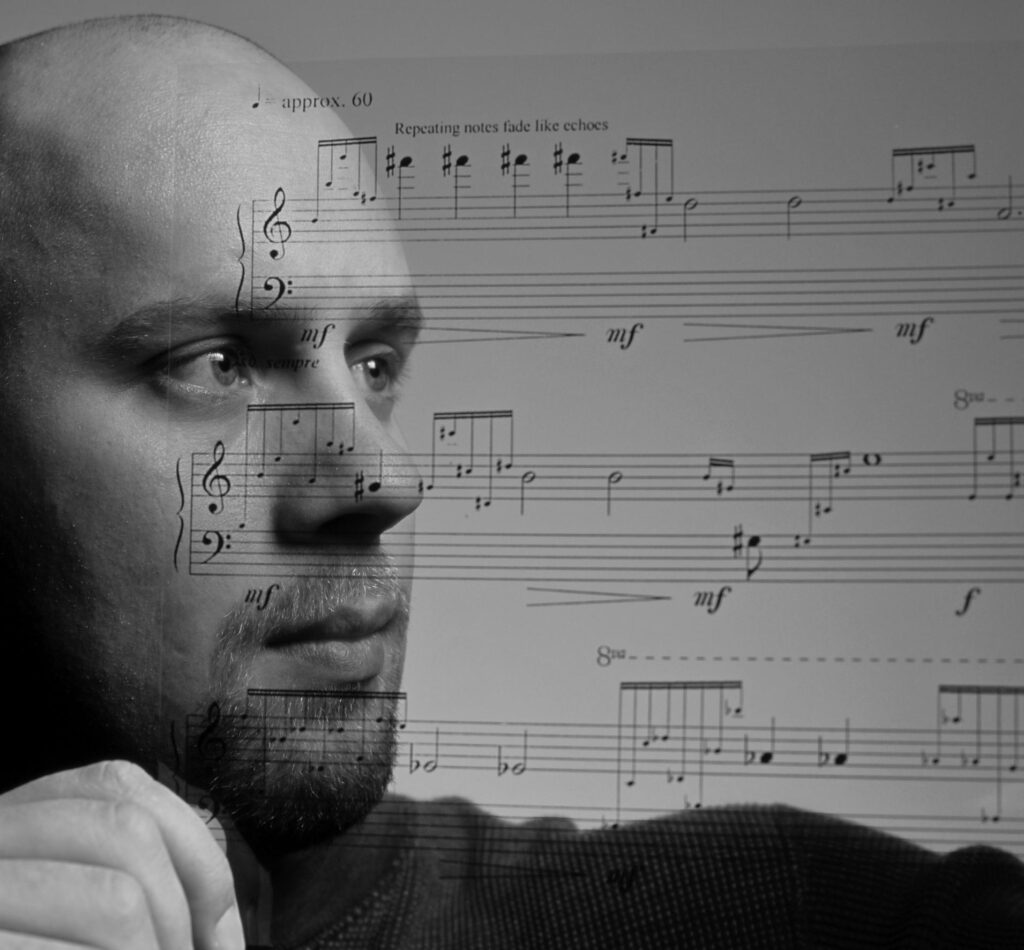
The significance of receiving this commission cannot be understated, says Nobles, who is honoured to have been recognized by the Azrieli Foundation. It was a “big deal,” he says, which made it hard to put pen to paper. When he set out to write a piece that represented Canadian music, Nobles started by looking around him. “This country is bigger than I thought,” he laughs. Nobles took stock of all of the named places in Canada, observing “there are 350,000.” He decided to use place names to create the textual content of his piece, doing away with the colonial names for locations and instead looking to the original Indigenous names. When he started writing, he thought he would use the full Indigenous names for a small handful of Canadian locations. This quickly changed, though.
Instead of using these names in their entirety, Nobles broke them into fragments. This, he says, served a dual purpose: allowing him to include reference to more locations, and sacrificing the specific for an experience of Canadian geography that would, hopefully, be more universal. “I gathered these sounds that are sort of universal,” he explains, “to better describe my awe and joy at these places.” In Kantata for Large Choir, fragments are organized by geographical region, taking the audience from the Rockies, to the country’s beaches, the Saint Lawrence River, and the Canadian North.
The collection of “phonemes,” as he calls them, are used slowly—“often layered.” Nobles treats the text “not as words, but as texture, as timbre,” and finds this quite satisfying. He uses common tones, and common syllables, to shift between layered text fragments and harmonic areas. Nobles’s movement “through different harmonic centres thus mirrors his movement through different regions of Canada.” Although not explicitly painting sonic pictures of prairies or mountains, this is certainly meant to evoke the awe and grandeur of Canadian landscapes. He will not list any of the places referred to in the program; instead, he will “let audiences fill them in for themselves.”
The idea for Kantata for Large Choir came on a cross-Canada trip; it started out being about “showing our son how big the country is,” explains Nobles. “We took the train from Vancouver to St. John’s, Newfoundland, and back, to show my child where he lived.” The trip showed Nobles himself just how much of the country he had left to explore, despite his many previous journeys across Canada. It has led him to much more reflection on “that trip, other trips since, and many aspirational trips.”
“I can’t sing,” admits Nobles, “and I can’t whistle,” he adds with a laugh. Most of his writing projects are for large ensembles, very often monochromatic, in which blending sounds and creating texture is quite easy. Although he doesn’t end up writing for choir a lot, “it is a profound sort of sound, and it always feels quite profound” when he does. The human voice can really draw you in; it has a universal quality to it.” This piece is one of his most difficult for choir, and Nobles confesses he is anxious to see how it will be pulled off.
The works’ harmonic motion starts out very slowly, and accelerates. At first, the movement from one tonal centre to another is so gradual that “it’s almost indetectable.” Although the harmonic language is similar to things he has written in the past, he has never used this technique of acceleration on this scale.
The piece ends with an epilogue, called home, during which Nobles has not picked the text. Instead, the choir will. “They are instructed to sing the words of the places they call home, in whichever language they want,” he says.
When faced with the question of what Canadian music is, Nobles hesitates. “We are so connected to the whole world, I don’t know what Canadian music is anymore; it’s totally opened up. There are so many cultures, so many instruments, so many influences that make up Canada.” It’s for this reason that he looked to the question of “what is Canada? What is this place, in which we live and work?” For Nobles, Canadian music is thus a way to highlight the assemblage of the places that are significant to both those who visit, and those who call this country home.
The piece will not come to life until it is in the choir’s hands. Nobles is especially looking forward to hearing them sing the epilogue on Oct. 28. Together, they will entone the names of their homes—at once celebrating their unique relationships to the places that are special to them, and celebrating the country as a whole, and all that it has to offer.
Juan Trigos: Indigenous Mexican sonorities
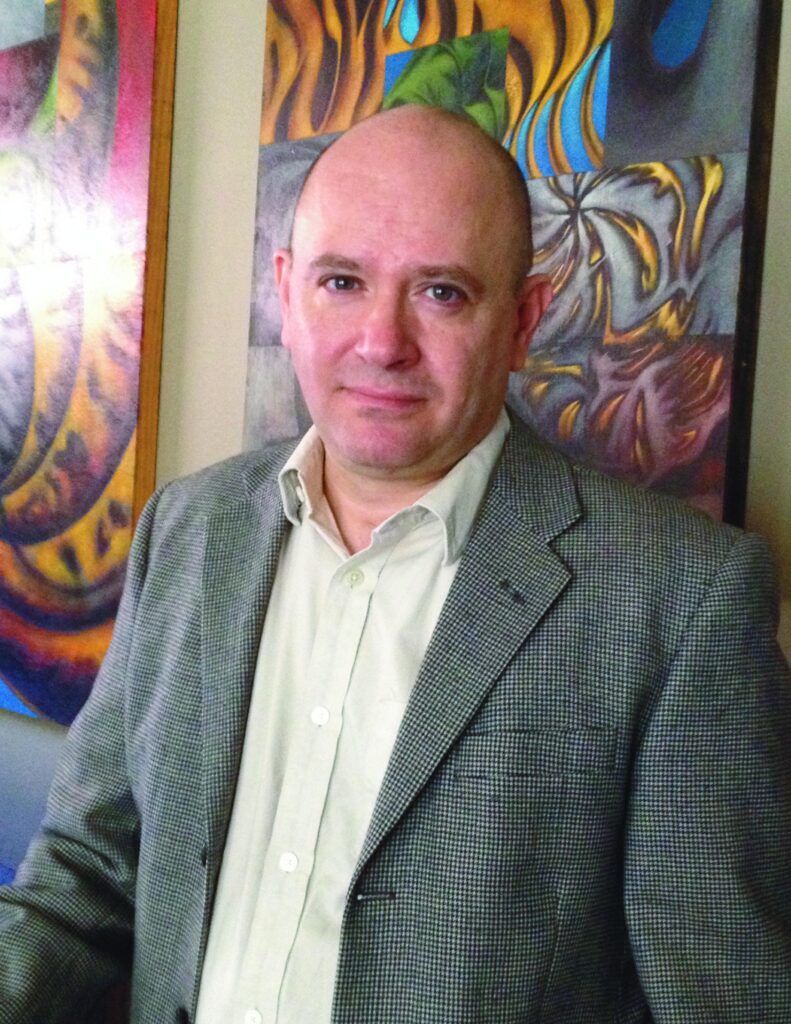
“Abstract folklore” refers to the approach Trigos takes to combining disparate traditional elements to create his own contemporary style. “My musical personality is a result of all of the musics I have digested, and built into myself,” he says, adding: “Abstract folklore can be understood as encompassing many things—an attachment to the earth, to the many traditions we have. Every culture has folklore.” The folklore closest to him personally is that which he was surrounded by “at home, on the streets of Mexico city. When you go out, you hear all kinds of folklore—folk music from all around the world.”
Simetrías Prehispánicas (Prehispanic Symmetries), for which Juan Trigos received the Azrieli Commission for International Music, is completely representative of Trigos’s compositional curiosity, his desire to innovate, and his attachment to the sounds with which he grew up.
The piece combines texts by Aztec poets such as Aquiauhtzin, Cacamatzin, Macuilxochitl, Nezahualcoyotl, Tecayahuatzin, and Yaocuicatl, to tell an abridged version of the Spanish conquests of Mexico, in both their original language (Nahuatl) and Spanish. These disparate textual sources were woven together into a collection of “poetic inventions” for the work by Trigos’s father, the playwright also named Juan Trigos. Trigos and his father have worked together throughout his career, the son noting that “he has written the librettos for all of my operas.”
Here, his father has “put (these various poetic excerpts) together,” says Trigos, “to tell the story of the founding of Mexico City” and the Aztec Empire. The legend is that the Aztec gods told their people that the perfect place to build their city would be brought to their attention by “an eagle eating a snake.” When the Aztecs found the eagle in the centre of a valley, they settled in the area, which ultimately became Mexico City.
The eagle and the snake have remained important symbols in Mexican culture, and are represented in the coat of arms on the country’s flag. Trigos “remembers being impressed as a kid by the mythical idea of these two animals.” Prehispanic Symmetries uses repeated text and images as structural starting points, integrating stories of sacrifice and war, poetry about flowers, and erotic scenes into the mix.
Musically, Trigos found inspiration for the work’s melodic and harmonic content from the textual material. Cultivating a relationship to literature has been an important part of his career, he says. When Trigos sets out to put a text to music, he first “tries to find that which evokes music in the text. It’s about the sound image a text creates; I use this to find the rhythm, the notes, and so on.”
Trigos admits that while he is not a singer by trade, he “sings every day.” It therefore comes as no surprise that he has written so many songs, cantatas, operas and masses. Originally, he expected Prehispanic Symmetries to be an exclusively vocal work. As the piece took shape, though, the addition of piano, percussion, trombone and flutes felt intuitive. Trigos describes percussion as “his second love, after voice,” and notes the particular relevance of flute timbres in the context of this piece. “Indigenous music in Mexico has a lot of flutes. I wanted to evoke those sonorities, and the effects of various different flutes—reeds, clay, metal.” Along with the percussion, the trombone is also meant to evoke traditional Aztec sounds: in Prehispanic Symmetries, Trigos uses it to mimic the timbres of both “the conch, which is very strong, very loud, and another instrument, the Mayan pipe.” In communion with the choir, who create “lots of different vocal sounds and colours,” these instruments are meant to draw listeners into Trigos’s folkloric sonic universe.
Trigos looks forward to hearing Prehispanic Symmetries in its entirety at the Azrieli Music Prizes Gala Concert in Montreal’s Maison symphonique on Oct. 28. As a composer and conductor, he is intimately acquainted with the challenges of bringing a new work to life from the podium. “You can’t separate composer from conductor; I’m happy that there’s no need to choose.” He points out that as much as he loves to write, he loves to perform, particularly “20th-century and contemporary music.”
Although he will not be leading the choir and ensemble on the 28th, he sees this as “a wonderful thing” in itself. It offers “a different point of view. It’s great for the music to have someone else conduct it.” He is eager to sit in on rehearsals and to help conductor Andrew Megill and the musicians as much as he can. “I love collaborating,” he says. “It’s such a beautiful thing.”
Trigos reflects on how honoured he is to have received this year’s Azrieli Foundation Commission for International Music, and to have his work stand alongside the ever-growing “tradition of new music in Canada. This is a big opportunity,” he says. “I’m really looking forward to (being in Montreal), to (hearing) the audience response, and to (seeing) what the musicians think.”
Azrieli Music Prizes’ Gala at Maison symphonique is on Oct. 28. For more on the four recipients of this year’s Azrieli Music Prizes: www.azrielifoundation.org
This page is also available in / Cette page est également disponible en:
![]() Francais (French)
Francais (French)

